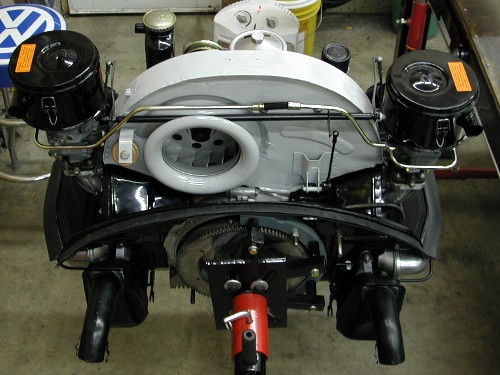Ok. Getting ready to install my 2110 with dual 44s and the only hold up is pulling the trigger on the proper tin. It's taken a month of research and 2 weeks of back and forth e-mails full of options from Clark at awesomepowercoating.com where I'm ordering things.
I was ready to go with the OEM doghouse with heat modified for type-4 cooler running flaps and thermo. Then from advice here, found unless I want to spend an extra grand on 1 5/8 heater boxes to match the 1 5/8 exhaust I need for the engine (another $1,000-taxes, shipped with custom dual out) the cheaper (only other option) is to run no heat and j-pipes. Then planned on scat 36hp no heat, because VW OEM no heat doesn't exist except for one year 73" thing which are hard to find. Then reading (here) that Scat 36hp shrouds have many issues, don't cool as efficient, don't work well with flaps (will modify to fit) and have fitting issues. Now just ran across a post on this forum from Jake, stating that a particular aftermarket shroud (not named) cooled better then OEM and that install flaps on any shroud doghouse or none, heat/no heat raised tempature in all cases...
https://www.speedsterowners.com...795#2135445018335795
When i installed the flaps and thermostat in the test shrouds we saw the engine temps GO UP all the way across the board...
I'm assuming it's the DTM but I don't have the budget for it.
So I should already have my engine installed at this point, but the hold up is make the right tin (shroud) choice. However, the more research I do to make the best decision, the more conflicting information I seem to find. Very confusing!
I know it comes down to personal choice, but I'm trying decide based on others failed attempts and success, though I'm not finding definitive results—other then proven tests from Jake. Most here state it works for them, others use OEM only!
I would like to order today and be done with it!
So can some one please clear the air that running none heat Scat 36HP no flaps or flaps will run properly on a 2110 (with modify for stock flaps and type 4 cooler) will operate correctly? I would like to use a OEM Doghouse, but plugging caps aren't a great option?, and no heat doghouses do not exist (other then the 73" thing) Again, looks like Jake is saying flaps increase temps as well. I live in Northern Va and will not run the speedster from November-Feburary or when it goes below 50 out. It's not a daily drive either.
Planning on first week in October install.
Thanks.


